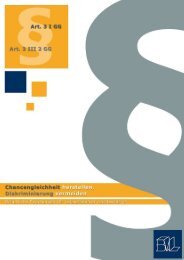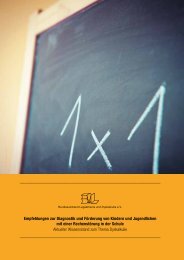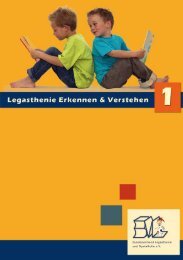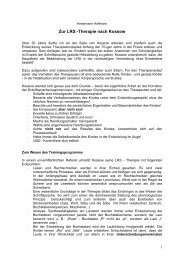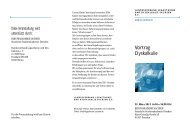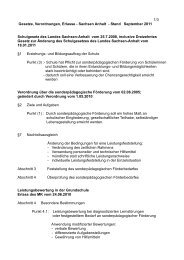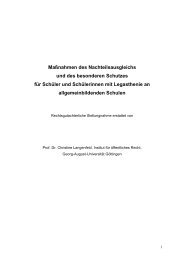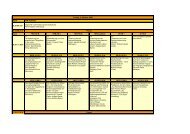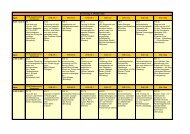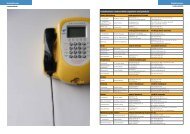Testverfah - Bundesverband Legasthenie und Dyskalkulie eV
Testverfah - Bundesverband Legasthenie und Dyskalkulie eV
Testverfah - Bundesverband Legasthenie und Dyskalkulie eV
Erfolgreiche ePaper selbst erstellen
Machen Sie aus Ihren PDF Publikationen ein blätterbares Flipbook mit unserer einzigartigen Google optimierten e-Paper Software.
Abstractband 15. Kongress des <strong>B<strong>und</strong>esverband</strong>es <strong>Legasthenie</strong><br />
cessing. Still, during the past 20 years, an accumulated body of data indicates that<br />
the prevalence of poor performance in a range of visual and auditory tasks is higher<br />
among dyslexics. The main open challenges are to determine the nature of these<br />
deficits and their functional implications.<br />
We fo<strong>und</strong> that both in the visual and in the auditory domain, dyslexics had particular<br />
difficulties when asked to compare between sequentially presented stimuli, suggesting<br />
poor perceptual working memory. Visual comparison between the density of sequentially<br />
presented grating stimuli was poor among the majority of dyslexics. While<br />
most controls performed sequential comparisons better than simultaneous ones,<br />
dyslexic individuals showed no such trend. Yet, when required to identify briefly presented<br />
letters within word-like stimuli, but with no phonological content, dyslexics’<br />
performance was as good as controls’. These findings suggest that, although visual<br />
sequential memory in dyslexics is impaired, it may not play a functional role in their<br />
reading difficulties.<br />
A large subgroup of dyslexics, individuals with poor language and verbal-memory<br />
abilities, performed particularly poorly on a range of simple auditory tasks, most<br />
notably, frequency and duration discrimination. A similar type of deficit characterized<br />
their performance with speech stimuli and with simple tones. In contrast to controls,<br />
their performance with a small stimulus set was not better than that with a large<br />
stimulus set, indicating their lack of ability to utilize stimulus repetition to improve<br />
attention by “tuning in”. We propose that this deficit in forming on-line memory traces<br />
is a major contributor to their reading and learning difficulties.<br />
Korrespondenzautor:<br />
Merav Ahissar<br />
msmerava@pluto.mscc.huji.ac.il<br />
++02 588 3195<br />
++02 588 1159<br />
Die Komorbidität von LRS <strong>und</strong> ADHS<br />
*Tobias Banaschewski (1), Marcus Hasselhorn (2), Margaret Tiffin-Richards (1),<br />
Aribert Rothenberger (1)<br />
(1) Georg-August-Universität Göttingen, Kinder- <strong>und</strong> Jugendpsychiatrie/Psychotherapie, Göttingen,<br />
Deutschland; (2) Georg-Elias Müller Institut für Psychologie, Abteilung Pädagogische Psychologie &<br />
Entwicklungspsychologie, Göttingen, Deutschland<br />
Die Aufmerksamkeitsdefizit/Hyperaktivitätsstörung (ADHS) <strong>und</strong> die umschriebene<br />
Lese-Rechtschreibschwäche (LRS), zwei der häufigsten kinder- <strong>und</strong> jugendpsychiatrischen<br />
Beeinträchtigungen, treten überzufällig häufig gemeinsam auf.<br />
Welche neuropsychologischen Funktionsbeeinträchtigungen Kinder mit ADHS bzw.<br />
LRS unterscheiden <strong>und</strong> ob Kinder mit beiden Auffälligkeiten (ADHS + LRS) hinsichtlich<br />
dieser Merkmale den Kindern mit alleiniger ADHS, bzw. den Kindern mit<br />
alleiniger LRS, gleichen oder spezifische, eigene neuropsychologische Charakteristika<br />
aufweisen, ist nicht nur eine wichtige Forschungsfrage, sondern auch für die<br />
Diagnostik <strong>und</strong> Behandlung betroffener Kinder wesentlich.<br />
4



